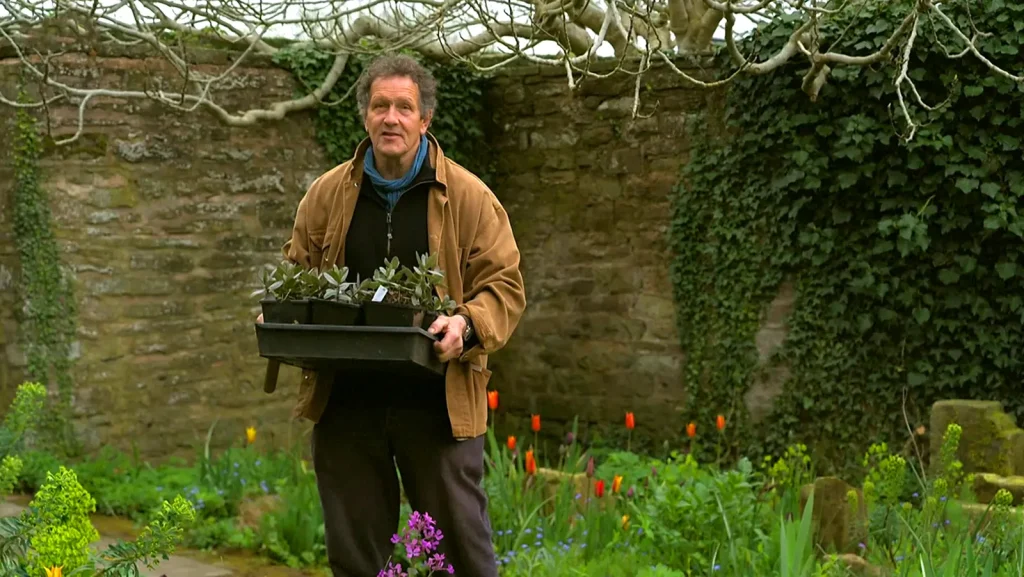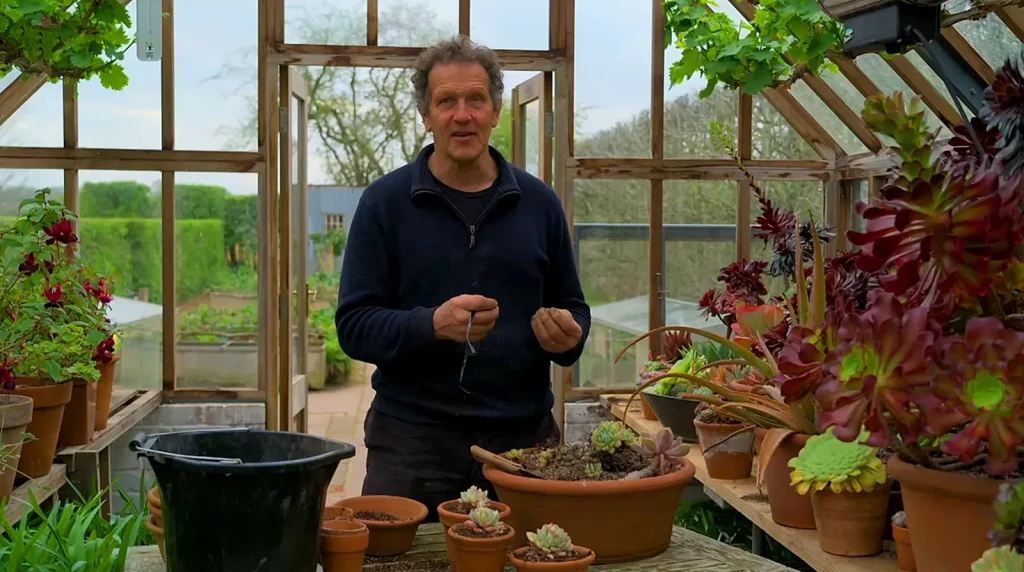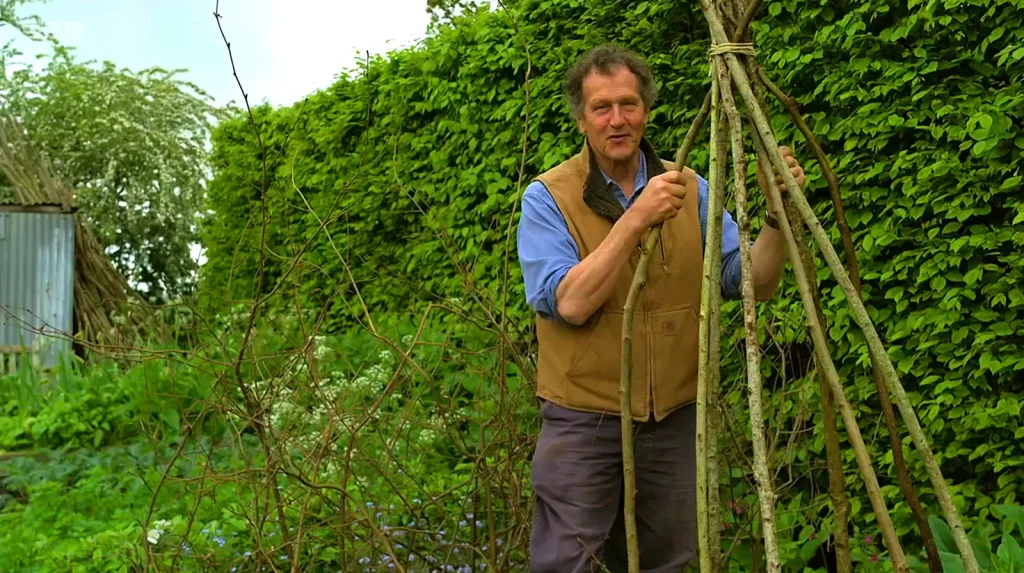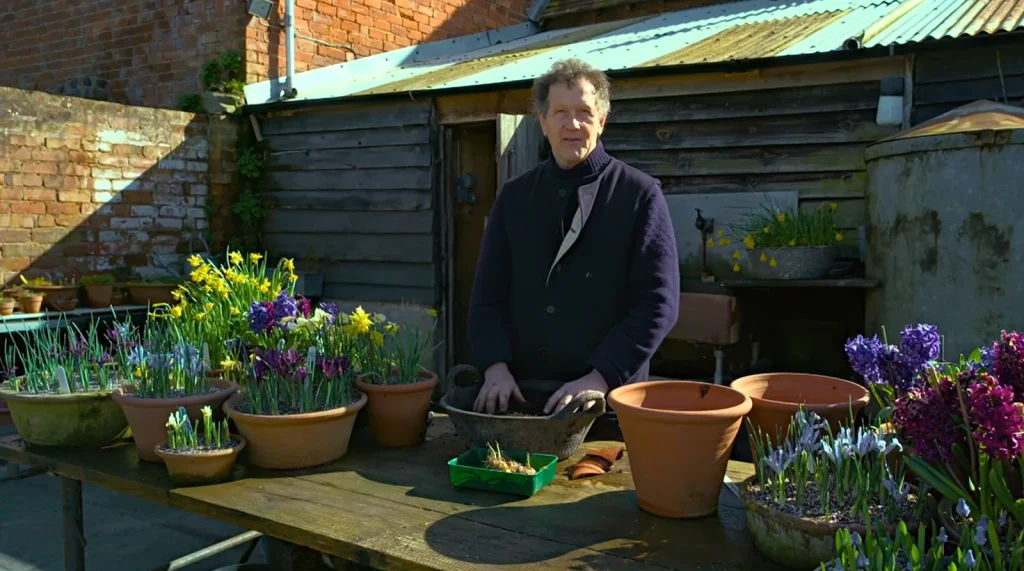Gardeners World 2024 – Compilations episode 3: In the heart of winter, when the days are short and the nights long, “Gardeners’ World” emerges as a beacon of inspiration and joy, offering a burst of vibrant color and a reminder of the spring to come. Led by the esteemed Monty Don and his dedicated team, the show embarks on a nostalgic journey, revisiting some of the most memorable moments and highlights from its rich history.
At the core of this episode, Monty Don himself takes the stage, sharing his expertise and passion for gardening as he demonstrates how to breathe life into shaded areas of the garden. With a careful selection of shade-loving plants, he skillfully plants up a series of pots, crafting a stunning summer display that promises to transform any shadowy corner into a lush, inviting oasis.
Joining the adventure, Arit Anderson travels to a heartwarming community garden nestled in West Sussex. This special place serves as a sanctuary for young carers, a group of remarkable individuals who find solace, companionship, and fun within its green embrace. Here, amid the tranquility of nature, they experience a much-needed respite from their responsibilities, forging bonds of friendship that extend beyond the garden’s boundaries.
The journey continues to Liverpool, where Toby Buckland unveils an inspiring story of community transformation. Through the collective power of gardening, a neighborhood breathes new life into their urban environment, regenerating their streets with lush plantings that foster a sense of pride, beauty, and togetherness.
In Bristol, Joe Swift explores an extraordinary project that takes community gardening to the next level. This initiative focuses on food production, where residents come together to grow a diverse array of fruits and vegetables. This not only promotes sustainable living but also strengthens the community bond, as they share the fruits of their labor and the joys of gardening.
Gardeners World 2024 – Compilations episode 3
The episode also features a London-based interior designer whose innovative use of houseplants has enabled him to forge a deeper connection with nature, right in the heart of the city. His home becomes a green sanctuary, demonstrating how indoor gardening can enhance our well-being and bring a slice of the outdoors into our living spaces.
Adding to the rich tapestry of stories, we meet an enthusiastic allotment holder renowned for cultivating an impressive variety of unusual vegetables. This segment showcases the joy and satisfaction derived from growing your own food, highlighting the diversity of produce that can be achieved with a little knowledge and a lot of passion.
Lastly, the show takes us on a trip down memory lane, revisiting the heartwarming story of three sisters from Dorset—Mandy, Kirsty, and Becky. Their gardening adventures first featured on the show, capturing the hearts of viewers on social media and beyond. Their passion for gardening, combined with a contagious enthusiasm, exemplifies how gardening can bring people together, creating a sense of community and shared joy.
Through these stories, “Gardeners’ World” not only offers a welcome escape from the winter chill but also serves as a source of inspiration and motivation for gardeners everywhere. Whether you’re a seasoned gardener or just starting, the show invites you to explore the endless possibilities that gardening presents, encouraging you to get your hands dirty and experience the magic of growing.
The Ultimate Guide to Growing Strawberries at Home
Growing strawberries at home is a delightful and rewarding gardening project that can yield delicious and juicy fruits from early summer through to autumn. This comprehensive guide covers everything from selecting the right strawberry varieties to planting, care, and harvesting your home-grown strawberries. By following these expert tips, you’ll be able to enjoy the freshest and most flavorful strawberries right from your own garden.
Getting Started with Strawberry Growing
Choosing the Right Varieties
There are three main types of strawberries to consider for your garden:
- Summer-fruiting strawberries are popular for their large fruit and concentrated cropping period. They come in early, mid, and late fruiting cultivars.
- Perpetual strawberries, or everbearers, produce smaller fruits over a longer period, from early summer to the first autumn frosts.
- Alpine strawberries offer dainty plants with tiny, aromatic berries over the summer. They can be red, white, or yellow and are perfect for edging or ground cover.
To extend your harvest season, consider planting a mix of these types. Look for varieties with an RHS Award of Garden Merit (AGM) for assured quality and performance.
Preparing the Ground
Before planting, enrich the soil with well-rotted manure or garden compost and a high potassium fertilizer. Using a weed-suppressing membrane can also help manage weeds and keep fruits clean.
Planting and Growing Strawberries
Planting Techniques
- In the ground: Plant strawberries in spring or late summer/early autumn for optimal growth. Space plants 35-40cm apart in rows 75-100cm apart.
- In containers: Suitable for those with limited space, strawberries thrive in pots, hanging baskets, and grow bags. Ensure regular watering and feeding.
Growing in a Greenhouse
For an earlier harvest, grow strawberries under cloches or in a greenhouse. Move plants indoors in February or cover outdoor rows with cloches.
Strawberry Plant Care
Regular maintenance is key to a bountiful harvest:
- Watering: Keep plants hydrated, especially during dry spells. Avoid wetting the crown or fruits.
- Feeding: Apply a high potassium fertilizer in early spring and throughout the growing season for container-grown plants.
- Mulching: Use straw around plants to keep fruits clean and deter weeds.
Harvesting Strawberries
Pick ripe berries in the warmest part of the day for the best flavor. Protect fruits from birds and pests with netting or fruit cages.
Mastering the Art of Growing Ranunculus: A Comprehensive Guide
Ranunculus, with their mesmerizing blooms ranging from the lush petals of Persian buttercups to the simple charm of meadow buttercups, offer a delightful addition to any garden setting. Admired for their variety and vibrant colors, these flowers not only enhance the beauty of your garden but also serve as a vital source of nectar for pollinators. This guide dives deep into the intricacies of growing ranunculus, ensuring that gardeners of all levels can cultivate these stunning plants successfully.
Choosing the Right Ranunculus
For Every Garden Niche
Selecting the appropriate ranunculus species is crucial for harmonizing with your garden’s specific conditions. For moist, partially shaded areas, consider the hardy, low-growing Ficaria verna, perfect for borders and providing early spring color. For sunnier borders, the double-flowered Ranunculus acris ‘Flore Pleno’ offers striking blooms. Meadow and bog buttercups, such as Ranunculus acris and Ranunculus bulbosus, thrive in damp meadows and are excellent for attracting pollinators. For those with water features, aquatic varieties like Water crowfoot (Ranunculus aquatilis) create a naturalistic charm.
Bedding and Container Beauties
Persian buttercups (Ranunculus asiaticus) are the go-to choice for container gardening, offering a wide range of flower colors. These plants are also cherished as cut flowers, bringing the beauty of your garden indoors.
Alpine Specialists
For rock gardens or alpine glasshouses, species like Ranunculus alpestris and Ranunculus glacialis are well-suited, thriving in well-drained, sunny locations.
Planting Guidelines
Ideal Conditions and Timing
Plant ranunculus in damp, well-draining soil, avoiding deep shade to ensure blooming. Spring is the perfect time for planting, allowing plants to establish before the growing season. Persian buttercups benefit from pre-soaking and should be planted in well-draining compost with added grit for optimal growth.
Planting Techniques
For borders and meadows, plant ranunculus at the same depth as the pot. For Persian buttercups, tubers should be placed claws downward and covered with compost. Alpine varieties prefer gritty, humus-rich soil and thrive in full sun.
Ongoing Care and Maintenance
Watering and Feeding
Regular watering is crucial, especially during the initial months and the flowering period. Feed border plants in spring with a balanced fertilizer to encourage robust growth.
Deadheading and Overwintering
Remove spent flowers on alpine and border plants to promote further blooming. Most ranunculus are hardy and require minimal winter care, though Persian buttercups should be overwintered in a cool greenhouse.
Propagation Techniques
Spring is the ideal time for propagating perennials by division. For Persian buttercups, seeds can be sown in autumn for flowering in the following year. Aquatic varieties can be divided or grown from seed, following specific germination conditions.
Problem-Solving
Maintain good air circulation to prevent powdery mildew and other fungal diseases. Some species may spread aggressively and require management to prevent them from overtaking other garden plants.
Selecting the Perfect Houseplants for Your Home
Houseplants have the remarkable ability to transform our living spaces, infusing them with color, life, and a touch of nature’s serenity. Not only do they enhance the aesthetic appeal of our homes, but they also promote mental well-being and improve indoor air quality. This article will guide you through choosing the right houseplants that will not only beautify your space but also thrive in their new environment.
How to Choose the Right Houseplants
Understanding Your Space
Before diving into the vast world of houseplants, it’s crucial to assess the specific conditions of your home. Consider factors like light exposure, humidity levels, and temperature fluctuations in different areas. This initial step ensures that your chosen plants will not just survive but flourish.
Light Requirements
Plants have varied light needs, ranging from low to high. Identify which areas in your home receive ample sunlight and which are more shaded. Remember, the intensity of sunlight changes with the seasons, affecting where you might place your plants throughout the year.
Humidity and Temperature
The humidity and temperature in your home can greatly influence plant health. Kitchens and bathrooms usually offer higher humidity, which is perfect for tropical plants, while living rooms might have drier air, especially in winter. Understanding these conditions will help you select plants that are best suited to your home’s environment.
Recommended Houseplants by Location
For High Light and Warmth
If you’re blessed with a sunny south-facing windowsill or a warm conservatory, consider succulents like Agave or Echeveria, or vibrant flowering plants such as Bougainvillea and Hibiscus. These species thrive in bright light and can tolerate the heat that comes with direct sunlight.
For Low Light Conditions
North-facing windows or shaded areas are perfect for plants like the Spider Plant (Chlorophytum comosum), Prayer Plant (Maranta leuconeura), and the ZZ Plant (Zamioculcas zamiifolia). These species require minimal light, making them ideal for less sunny spots in your home.
For Varying Temperatures and Light
Hallways or rooms with fluctuating conditions can be challenging for some plants. However, species like the Cast Iron Plant (Aspidistra elatior) and the Parlour Palm (Chamaedorea elegans) are resilient and can adapt to a wide range of environments.
For Humid Environments
Bathrooms with their higher humidity levels open up a niche for plants like Ferns, the Peace Lily (Spathiphyllum), and Orchids. These plants thrive in moist air, making them perfect for such spaces.




